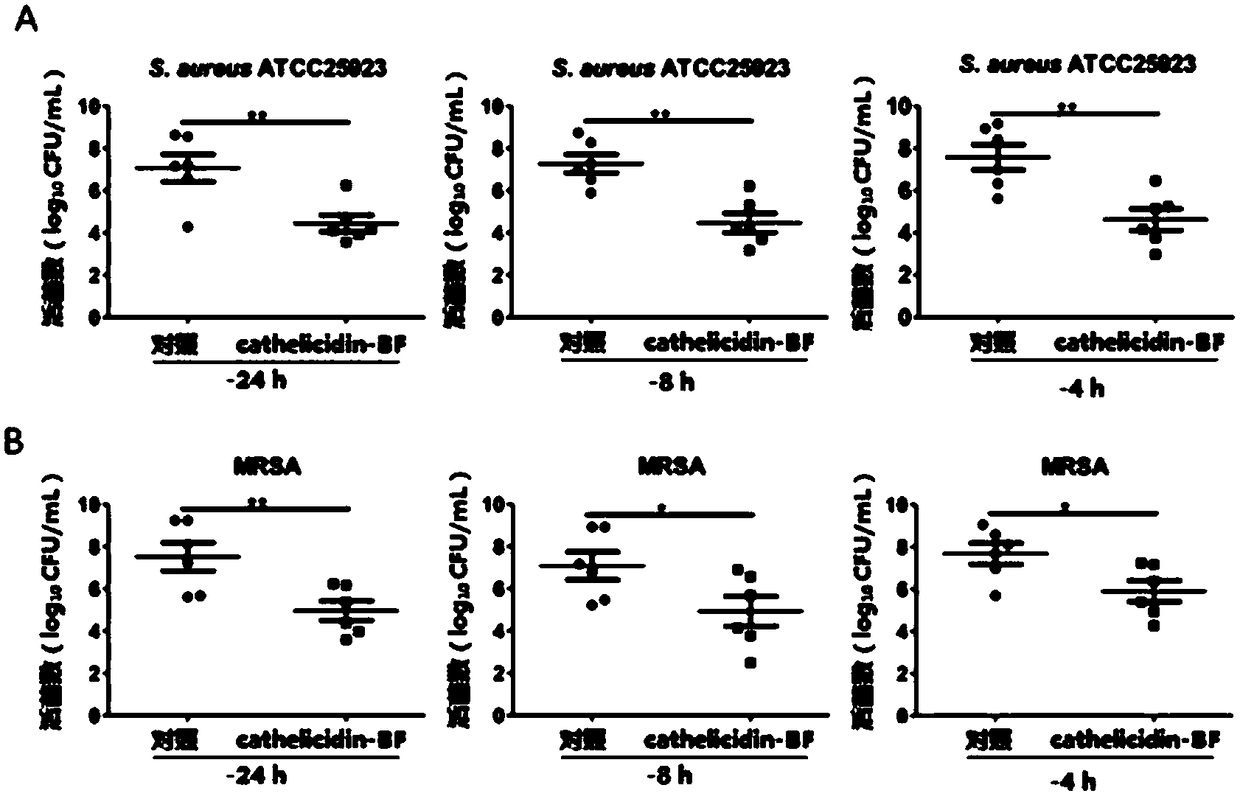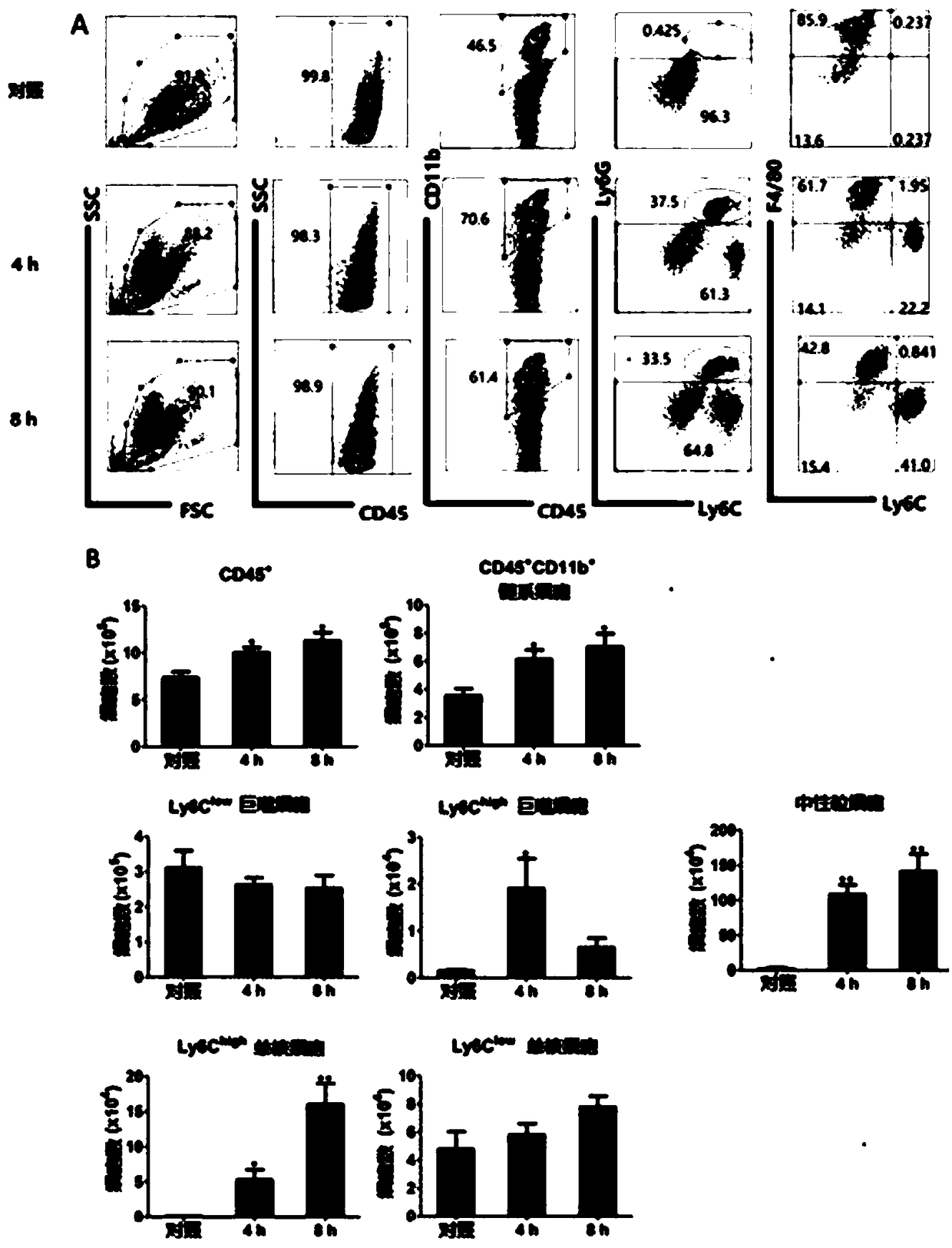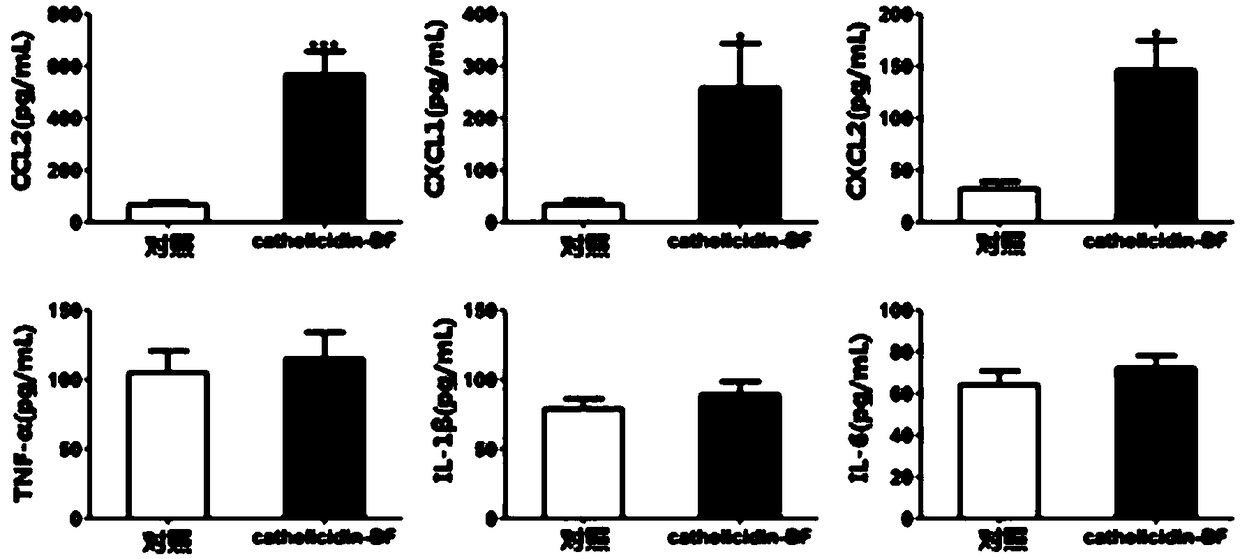Application of innate immune activation peptide
An innate immunity and krait antibacterial peptide technology, applied in the field of biomedicine, can solve problems such as the loss of efficacy of antibiotic treatment, insufficient research and development of new anti-drug-resistant bacteria antibiotics, etc., to achieve enhanced antibacterial innate immune response, easy chemical synthesis and protein expression , the effect of small molecular weight
- Summary
- Abstract
- Description
- Claims
- Application Information
AI Technical Summary
Problems solved by technology
Method used
Image
Examples
Embodiment 1
[0028] Pre-injection of cathelicidin-BF can effectively enhance the resistance of mice to S.aureus infection:
[0029]Experimental Animals SPF-grade C57BL / 6 mice, 6-8 weeks old, weighing 18-20 g, female, were purchased from Shanghai Slack Animal Co., Ltd. [SCXK (Shanghai) 2012-0002]. Mice were randomly marked and caged in the SPF animal room of Soochow University. Staphylococcus aureus S.aureus (ATCC25923) and clinically isolated methicillin-resistant Staphylococcus aureus (methicillin-resistant S.aureus, MRSA) were preserved in our laboratory. Cathelicidin-BF polypeptide, human cathelicidin antimicrobial peptide LL-37 (synthesized by Shanghai Gil Biochemical Company). Experimental animals and grouping C57BL / 6 mice were randomly divided into two groups, 5 in each group, the control group was solvent (PBS) injection group; the experimental group was cathelicidin-BF injection group (10mg / kg). 24h (-24h), 8h (-8h) and 4h (-4h) before bacterial infection, respectively, intraperi...
Embodiment 2
[0032] Intraperitoneal injection of cathelicidin-BF can promote chemotactic migration of neutrophils and monocytes / macrophages to the local peritoneal cavity:
[0033] The neutrophils and monocytes / macrophages infiltrated in the early stage of bacterial infection are important phagocytic and bactericidal cells, which play a vital role in eliminating pathogenic bacteria. In order to clarify whether cathelicidin-BF can enhance the peritoneal infiltration of phagocytes and promote the clearance of S.aureus, cells in the peritoneal fluid were collected 4h and 8h after intraperitoneal injection of cathelicidin-BF in mice for flow cytometric analysis. Peritoneal cells (1×10 6 ) was resuspended in an EP tube, washed once with PBS, resuspended in 100 μL of PBS, added cell surface marker antibodies (anti-mCD45, anti-mCD11B, anti-mLy6G, anti-mLy6C, anti-mF4 / 80), and kept at 4°C After incubation on ice for 30 min, centrifuge at 1 500 r / min for 5 min, discard the supernatant, wash twice ...
Embodiment 3
[0036] Intraperitoneal injection of cathelicidin-BF can induce up-regulation of monocyte / macrophage and neutrophil chemokines in mouse ascites:
[0037] In order to clarify that cathelicidin-BF can recruit neutrophils and monocytes / macrophages to the local peritoneal cavity, the effect of cathelicidin-BF injection on chemokines was tested. Firstly, cathelicidin-BF (10 mg / kg) was injected intraperitoneally into the mice, and the ascites was collected 4 hours later, and the levels of chemokines and cytokines were detected by ELISA.
[0038] The results showed that compared with the control group, the production levels of chemokines (CCL2, CXCL1, CXCL2) in the ascites of mice injected with cathelicidin-BF were significantly increased, which were 8.4 times, 7.8 times and 4.6 times that of the control group mice, respectively. However, the levels of inflammatory cytokines (TNF-α, IL-1β, IL-6) in ascites of mice treated with cathelicidin-BF did not change significantly ( image 3 )...
PUM
 Login to View More
Login to View More Abstract
Description
Claims
Application Information
 Login to View More
Login to View More - R&D
- Intellectual Property
- Life Sciences
- Materials
- Tech Scout
- Unparalleled Data Quality
- Higher Quality Content
- 60% Fewer Hallucinations
Browse by: Latest US Patents, China's latest patents, Technical Efficacy Thesaurus, Application Domain, Technology Topic, Popular Technical Reports.
© 2025 PatSnap. All rights reserved.Legal|Privacy policy|Modern Slavery Act Transparency Statement|Sitemap|About US| Contact US: help@patsnap.com



